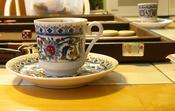 Yesterday we held another of our Colleague Tea events, this one entitled “Blogs at UVM“. It was a cozy group, with only about five or six people attending, but it was a lively and enlightening discussion. I think everyone left with some ideas about how they could use this tool in their courses. Here are a few of the resources we looked at, along with some of the places and ideas we discussed.
Yesterday we held another of our Colleague Tea events, this one entitled “Blogs at UVM“. It was a cozy group, with only about five or six people attending, but it was a lively and enlightening discussion. I think everyone left with some ideas about how they could use this tool in their courses. Here are a few of the resources we looked at, along with some of the places and ideas we discussed.
At the beginning, we gave out a resources sheet with the blog.uvm.edu url on it and descriptions of the tools that could be found there, such as the Get a Blog! link, the Blogroll, and the “help” blog. This handout also had URL’s for the Doctor Is In program, and the CTL Events calendar. We also had a “Blogging Lingo” (pdf) handout, definitions of common terms.
We started out with introductions, and discovered almost immediately that one of our participants was already blogging! She was excited to find out that she could set up a blog at UVM, in addition to using an external service – which she is currently doing with her Women’s Bioethics Blog.
In after looking at that blog, we went to the UVM Blogroll and took a look at a few blogs currently in use in the classroom. The blogs of Paul Martin‘s canadian literature courses were examples we looked at, as were Charlie Rathbone‘s education course blogs.
After that, we briefly looked at the editing and posting interface, and how easy it is to upload and post a picture. Throughout all of this, we were pausing to talk about the differences between using this tool as opposed to others such as WebCT or regular web/”zoo” space. Along the way we also discussed various details of using a blog, such as being able to save posts in unpublished “draft” form. We touched on ideas such as publishing multiple versions of syllabii, re-using a blog space, as well as ideas for handling discussion and dealing with comment spam. As we wrapped up, it seemed that a few folks might really have more need of something like WebCT, for it’s structure and tools such as quizzes and threaded discussion.
Toward the end, we looked at Technorati, and Google as ways of finding blogs of specific interest.
We also talked a little about feed readers.
All in all, it was a lot of fun. And the cookies were tasty!
